Flux Incarnate
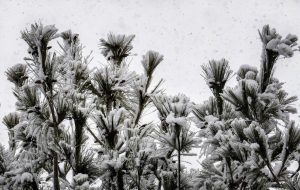 Needless to say, I find myself in an inchoate state of photographic growth. Meaning, there are acquired skills trying to reach another level of development. However, the threat remains ever constant that I may make wrong choices and not grow at all. Is this what is called “creative tension?” If it is, then, I guess, I have it. But it beats being stagnant!
Needless to say, I find myself in an inchoate state of photographic growth. Meaning, there are acquired skills trying to reach another level of development. However, the threat remains ever constant that I may make wrong choices and not grow at all. Is this what is called “creative tension?” If it is, then, I guess, I have it. But it beats being stagnant!
The photographic tension revolves around developing an “eye” to discern subtle changes in a photograph which either makes it or does not make it “exceptional” (that is, not ordinary). This involves a multitude of parameters to juggle all the way from capturing, processing, and then printing the photograph as seen by my eye.
“Having put my hands to the plow” re photography, the challenges remain forever great to overcome obstacles to achieving a continued process of seamlessly capturing what I perceive worthy of capturing, i.e., the ephemeral moments of my life.
The foregoing is an attempt to explain the complex state I am in…somewhat perplexing but also exhilarating in its aspirations.
The currently posted photo is of a White Pine by my house in the very cold and snowy January of 2018. My challenge to my self this month was to get out in the cold and capture the extraordinary in the ordinary. Whether I met that challenge is open to debate. However, the effort was none the less sincere. The main object was to capture a Snowy Owl (maybe I still will), but I will settle on the smaller creatures of creation, in its stead. The photo was taken with a Canon 5DS, EF100-400mm f/4.5-5.6L IS II USM @214mm, f/8, 1/640″, 800 ISO, post processed with Adobe Camera Raw, DxO Optics Pro 11, Gradient Map in PS, Color Efex Pro, and Viveza.
Staying Alive
 Whether I want to admit it to myself or not, the whole issue before us (myself, my loved ones, and the living creatures around me) is how to stay alive!
Whether I want to admit it to myself or not, the whole issue before us (myself, my loved ones, and the living creatures around me) is how to stay alive!
After 70+ years of life I have found that the most prominent element of what is around me is: staying alive. I have somewhat subconsciously realized this all of my life, but now it has reached critical importance. Probably because there is only so much time left for me to expend (?use up?). In other words, time is running short, as it were.
Okay. Maybe this is a bit over the top as far as blog dialog is supposed to go, but in the Winter of Our Discontent (read as God- Forsaken-Curse-of-a-Present-as-this) and as far as a Winter as hard as this (despite the denials of which the current President is saying regarding Global warming), then this is quite reasonable to say that I am in a phase of a somewhat gray-view of reality.
“So What!,” says the countering voice within me. “Falling in Love is Miraculous. It is realizing this fact that is important. I am in love with my wife. As always, I am involved with carrying on the process that I started when I was an infant, namely—living the wonders before me.”
I shoot photography to capture/steal moments. Moments which exist within a fraction (sometimes) of a second, but which are revealing and transcendent.
The currently posted photograph was taken in early morning at the beginning of January 2018. Life has been harsh this year with frequent winter storms of snow and wind. I have been feeding the birds, but the larger animals are on their own. Hence, the coyote seaching for his breakfast meal. It’s been hard for me watching this display of life trying to survive this winter: this ranges from Hawks killing other birds to survive to smaller birds fighting to get seeds from a feeder. That being said, the photo was taken with a Canon 5DS, EF100-400mm f/4.5-5.6L IS II USM @ 400mm, f/9.0, 1/500″, ISO 2000, post processed with Adobe Raw, DxO Optics Pro 11, gradient map in PS, and Silver Efex Pro.
More Versace
It’s been a fascinating month of photographic growth.
I embrace this monika phrase (of growth) simply because it capsulizes this process of capturing the ephemeral into a static frame, which is the moving process of understanding the dynamic process of trying to capture the un-capturable. Now, that is a phrase sequence which I wish did not happen. But, be that as was it may, I have re-visited Vincent Versace’s approach to photography…which, in my estimation, is profound in its simplicity.
Be that as it may, I have re-read Vincent’s book, Welcome To Oz 2.0, and have absorbed another 10% of the incredible amount of insight/information in it. This process has allowed me to get to the point of achieving the images I believed I was taking when I pressed the shutter button on my camera. I have another 80-90% of the Versace Process to go, but I am optimistic.
I have found that the Spirit which invades Vincent invades me. I may not have the talents/skills of Vincent, but I will proceed onward.
The current photo is of Occupessatuxet Cove, taken on December, 2017, toward the evening. I like the composition of the shot but the technical precision of the shot is missing. The phot was taken on a Canon 5DS, with a EF100-400mm f/4.5-5.6L IS II USM lens @ 400 mm, f/8.0, 1/160, ISO 640, post processed with Adobe Camera Raw, Photoshop Creative Cloud, using a gradient map and Nik Color Efex Pro.
Rediscovering Versace
About two years ago I made a significant jump in advancing my photographic skills by reading two books, Welcome to Oz, and From Oz to Kansas, by Vincent Versace. They were encyclopedic books to get through since they contained both a broad and specific attention to detail, outlining what it takes to make a good photographic print, i.e., a process starting at how you conceptualize what you want to take a photo of and proceeding all the way through to the final product of making the print.
I started on the journey two years ago of trying to master those techniques/skills and am still trying, but with the satisfaction that I am making progress. At the start of incorporating the points that Vincent presents in his books I chose the strategy of only adopting some at a time since the points are numerous. I believe I understand what I am doing now more than I ever have—some of this is conscious and some unconscious— but I think there is direction in what I am doing and not just random growth.
In any event, I have come to the realization that I can not only take photos and then just have digital representations of them (i.e., digital files). I must make prints to make any appreciable progress. I hesitated in buying a printer primarily because of the cost factor, but decided the time was right now since Canon offered a deal that was hard to resist; essentially getting a professional printer (Canon Pixma Pro 100) for a quarter of the cost. I could not go wrong.
I am quite happy with my decision not only because it is a quality printer (at an extremely attractive price) but also because it has allowed me to control more of how I can fashion in print the vision of what I actually saw at the moment with my camera. More will follower later regarding this.
The photo of the Northern Flicker was taken during an early December snow, and was not planned but hastily taken by sticking my head outside to my deck quickly so as not to frighten my feathered friend. A Canon 5 DS, EF100-400mm f/4.5-5.6L IS II USM @ 400mm was used with settings of f/6.3, 1/500″, ISO 1250, post processing with Adobe Camera Raw, Photoshop CC, DxO Optics Pro 11, using a Gradiant Map, and Nik Color Efex Pro.
Transient Moments of Beauty
For some reason the Muses have overtaken me at this most dark time of the year and have seen fit to energize not only my physical body but also my creative spirit. I am amazed at this occurrence, for truly I am repelled from the very cold that has enveloped New England in these winter months. But as I have observed the many creatures of nature and seen that they have embraced the challenge of being outside and facing the brutal elements of wind, temperature, and precipitation, I have become emboldened from their example.
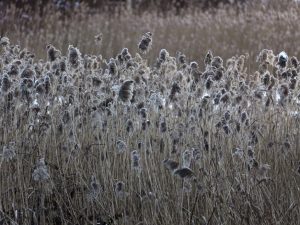 What I am trying to describe is that I have been going outside into the winter elements to capture the fragile and quickly vanishing moments that have been occurring. Naturally, I have chosen the various twilight times, simply because of the muted light, and, from what I discover, the increased activity of the various creatures at this time of day.
What I am trying to describe is that I have been going outside into the winter elements to capture the fragile and quickly vanishing moments that have been occurring. Naturally, I have chosen the various twilight times, simply because of the muted light, and, from what I discover, the increased activity of the various creatures at this time of day.
I have been rewarded beyond what I would have expected, having captured some very special moments of nature. The photo posted here is a very common view of marsh grass, but the hues and shades of stillness were uncommon features the eye may truly miss if not captures by the camera. I have been trying to capture these moments in my latest quest to explore photography.
Without getting too philosophical I will say that I am drawn to the in-between shots or phases of an event that is happening. For example, in regards to a person, if that person is looking at something, and then turns to look at something else, I am interested in the transition phase of the movement (aka photo shot).
The currently posted shot is on the shore of Occupessatuxet Cove, around the time of sunset in mid December — an enchanting time. The shot is of marsh grass (actually an invasive species, not good for the ecosystem). But, attractive, nonetheless. A Canon 5 DS was used, with a Canon EF100-400mm f/4.5-5.6L IS II USM lens @ 400mm, f/5.6, 1/500″, ISO 1600, post processed with DxO Optics Pro 11, Adobe Camera Raw, Photoshop CC (2018), and Nik Color Efex Pro.
Almost Getting It
This did not happen in my last shooting experience. This occurred today at the time of near sun set on a cloudy, windless day, in early December. Birds, geese and ducks were active or flocking, and the opportunities were happening hard and fast in things to photograph. All of a sudden, above me were several Canadian Geese coming in for a water landing. I quickly made sure my camera settings were adequate, and began making a series of shots as the geese approached and then landed. Surely, I said to myself, I must have at least one good photograph.
Unfortunately, if one considers sharpness as a critical element to a good photograph, I did not achieve my goal.
I offer the best of the lot for consideration and analysis in this blog post. I thought the lighting and form/movement/composition of the shot were what I wanted, and I am truly happy with those, but for some reason my camera settings were not adequate to achieving a sharp photograph. Maybe all things being equal, the lighting conditions were at the edge of what was achievable when you consider the fast movement of the landing geese. I will analyze this set of lighting, movement, and camera settings further to refine them so as to get a sharp shot.
The currently posted shot was taken on Occupexatuxet Cove using a Canon 5 DS, EF100-400mm f/4.5-5.6L IS II USM lens @ 400mm, f/8, 1/160″, ISO 1000, using DxO Optics Pro 11 for post processing, with Adobe Camera Raw, Photoshop CC(2018), and Silver Efex Pro.
Four Quartets
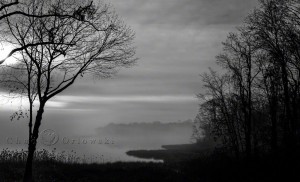 This enigmatic blog title is from T.S.Eliots’s poem of the same name. It has always resonated for me since I am committed to the dynamic nature of the way life presents itself; namely, in a series of apparent contradictions in an attempt to show us the sheer complexity of itself.
This enigmatic blog title is from T.S.Eliots’s poem of the same name. It has always resonated for me since I am committed to the dynamic nature of the way life presents itself; namely, in a series of apparent contradictions in an attempt to show us the sheer complexity of itself.
Enough of philosophy, though, and on with photography. Oh, but by the way, an encapsulated meaning of the poem (not doing it real justice) is, as Eliot states, “What we call the beginning is often the end. And to make an end is to make a beginning.”
I am using this reference to describe my current state in trying to become a photographer worthy of that name, and not simply someone that lucks out in taking photos, i.e.hit or miss. That current state is, unfortunately, one of unsuccessful attempts to acquire a thoroughgoing process of conceptualizing, actually taking, then processing, and finally printing the photograph I had in mind when I stood in front of the scene before me with my camera. After several years of trying to acquire skills through reading, attending workshops, and then experimenting with different techniques, I am left unfulfilled and inchoate.
But fate has smiled on me, since I recently discovered an artist and teacher worthy of those titles. His name is Vincent Versace. After reading an interview of him and also an articled on processing black and while photos, I purchased his book, Welcome to Oz 2.0. It is the second revision of his original work, Welcome to Oz, but I would have to say that he has so much information and pearls of wisdom in this book that I feel that I have found a gold mine.
After recently hitting the nadir of photographic growth I believe that I have been saved by whatever guardian there is of photographers that watches over us.
I am posting a photo of no consequence subject-wise, but one I feel challenged me to use some of the ideas that Vincent Versace expressed. I used a gradient map to make a black and white photo of a misty morning. I chose this scene since it seemed to challenge me to understand and bring out the tonality that was before me. These are very simple concepts to the accomplished photographer but not to me, who was trained to think verbally, not visually.
The photo was taken in full color with a Canon 5 Ds, using a 16-35mm lens, f/2.8, @35mm, f/11, 1/250, iso 250. Conversion to BW done in Photoshop, Gradient Map, and denoised in DxO, and stylized in On1 Photo 10.
Shooting Like Liberty Valence
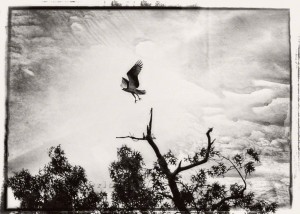 Liberty Valence was a gun slinger, and according to lyrics to the song made famous by Gene Pitney (writers: Hal David, Burt F. Bachrach, Burt Bachrach): “…the point of the gun was the only law that Liberty understood. When it came to shooting straight and fast, he was mighty good.”
Liberty Valence was a gun slinger, and according to lyrics to the song made famous by Gene Pitney (writers: Hal David, Burt F. Bachrach, Burt Bachrach): “…the point of the gun was the only law that Liberty understood. When it came to shooting straight and fast, he was mighty good.”
I’m finding that in sports and wildlife photography “straight and fast” are especially rewarding. So far in using my new Canon Eos 5 Ds, it was in game practice at the Patriots summer training camp, and more recently in following the pursuits of Ospreys in catching fish in my neighborhood (Occupessatuxet Cove, RI). Verily, I must say that the 5 Ds was quite responsive, i.e., fast. Since all shooting so far has been by hand held method (not tripod), I’d also have to say the 5 Ds was “straight” (i.e., steady).
The photo of this post was taken after the Osprey was perched a while on a branch back-lit by the sun on an overcast day. The camera was able to catch the energy released by the osprey, most easily seen in the wings and powerful talons. However, something was missing, and the easiest fix was to frame the subject and this “energy release”. This was done in Perfect Photo Suite 9 Borders (specifically, Russel). Oh yes, prior to the Borders being added, I tranformed the photo to b & w in PPS9 Black & White module (Rugged).
Spring: Post Mortem
- At June 06, 2015
- By Firstmate
- In Germany, Occupessatuxet Cove
 0
0
There still is life in this body and this blog. The exigencies of surviving winter trumped all other interests including posting to this blog. Let me explain.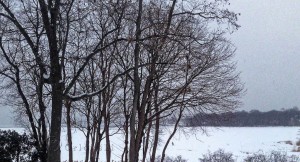
It was a terrible winter. Since arriving in New England 36 years ago from Wisconsin I used to laugh at the responses of locals on how terrible the winters were. In short, they were nothing in comparison to those of the Midwest. However, this past winter made up for all previous 36 winters by being the winter-from-hell, if that could be fathomed. The snow was constant from February on, and the temperatures were routinely in the teens or single digits, as meteorologists are fond of saying.
I tried to take photos but the body was not conditioned for it. What shots I took were not worthy even to be tossed into the waste basket—shivering has a way of destroying sharpness.
The first photo in this post was taken with my iPhone after sunset. Oh, by the way, it was snowing. It is of a lone soul skiing across Occupessatuxet Cove. The Cove was frozen from February to the beginning of April—quite a feat since it is salt water. As bad as it was in Rhode Island, Massachusetts and Boston were even worst.
 The second photo is of the breakout, my take on surviving the Winter That Was. It was taken in Nuremberg, Germany, in one of the many local restaurant pubs which had wonderful German food and beers. In this shot there are Nuremberg Bratwurst and potato pancakes, plus the obligatory beer, in this case a doppelbock from the local brewery next door.
The second photo is of the breakout, my take on surviving the Winter That Was. It was taken in Nuremberg, Germany, in one of the many local restaurant pubs which had wonderful German food and beers. In this shot there are Nuremberg Bratwurst and potato pancakes, plus the obligatory beer, in this case a doppelbock from the local brewery next door.
Photographically, there is not much to talk about since the best camera available was the iPhone. The winter shot is grainy due to the low light; the second shot is delightful in its own right due to its mere content.


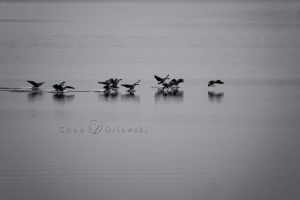 While my comfort and confidence levels continue to grow in taking photographs, the results are not always up to what I expected. Obviously, the elements of a great shot under a range of varying conditions is challenging, but I, nevertheless expect to at least get a good quality shot, at least with the top-notch, Canon equipment I use.
While my comfort and confidence levels continue to grow in taking photographs, the results are not always up to what I expected. Obviously, the elements of a great shot under a range of varying conditions is challenging, but I, nevertheless expect to at least get a good quality shot, at least with the top-notch, Canon equipment I use.
Recent Comments